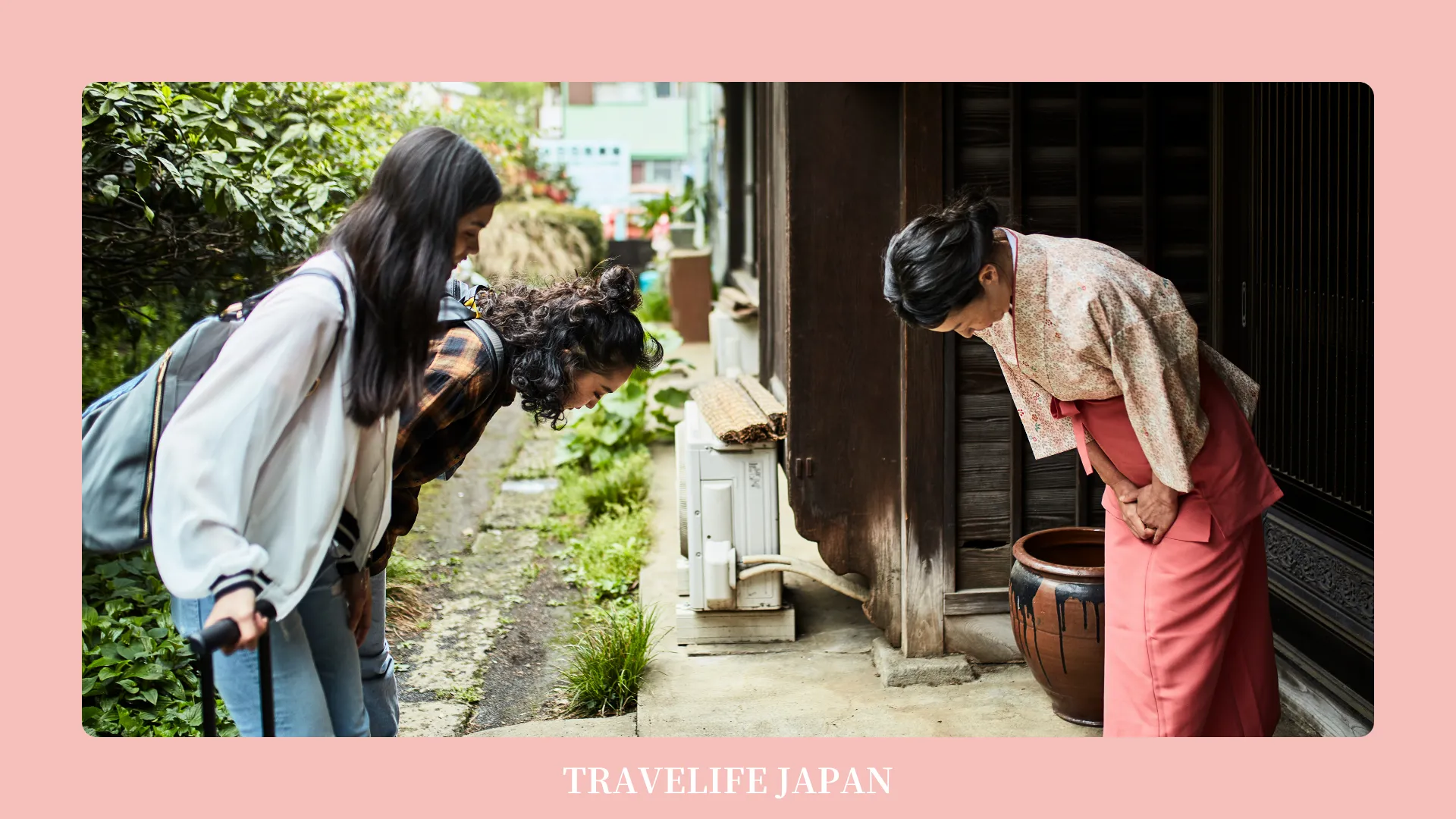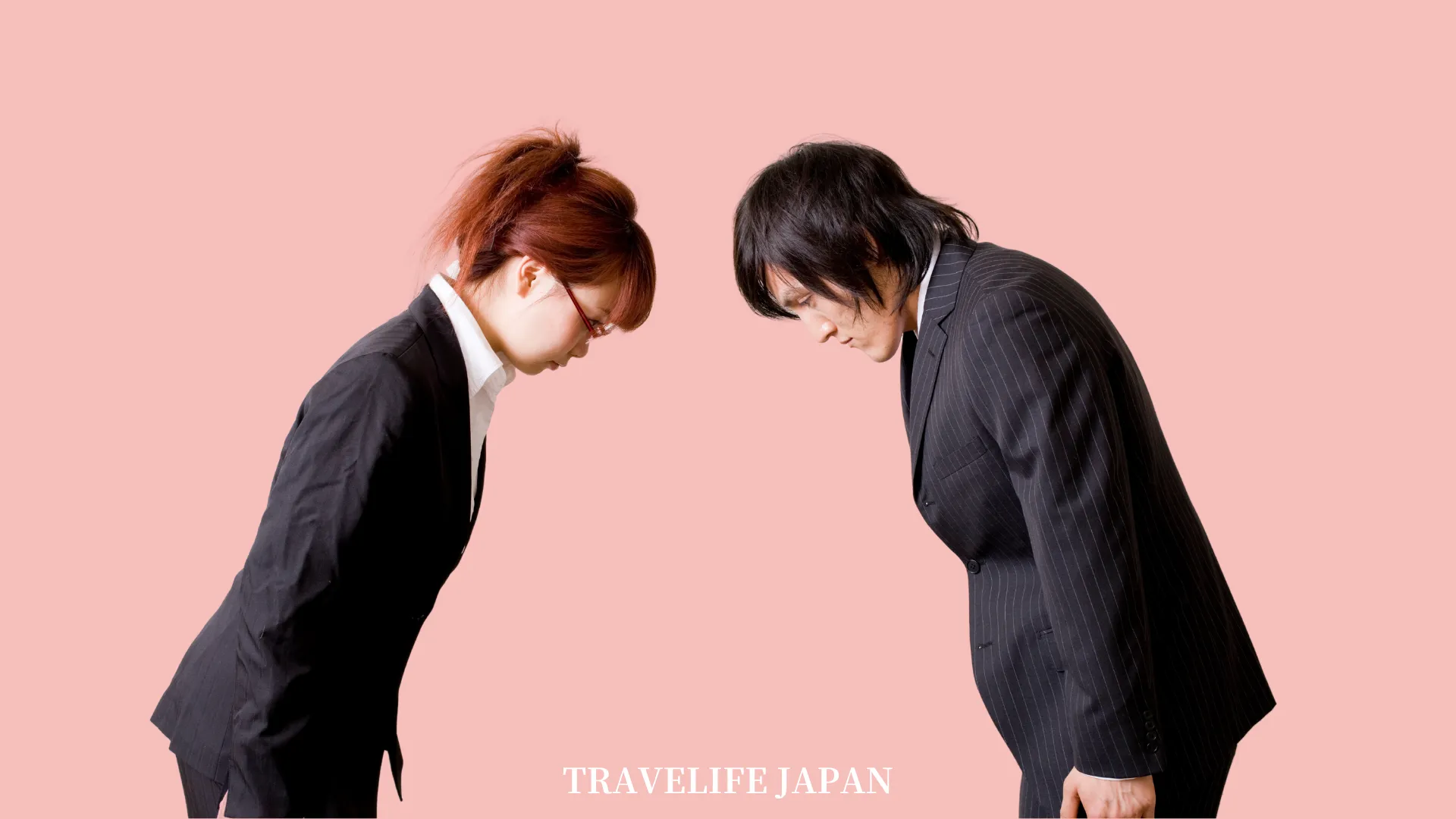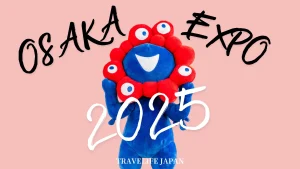Interested in Japanese culture? Learning greetings and etiquette is key, not just for language mastery, but to truly engage with Japan’s cultural values of respect, harmony, and modesty. This guide dives into the nuances of Japanese social interactions, providing vital insights for learners and those wishing to navigate Japan with cultural sensitivity.
Basic of Japanese Greetings

Mastering Japanese greetings is about understanding not just the words, but the context and cultural nuances they carry. Here’s an introduction of some common verbal greetings in Japanese and their appropriate usage:
Standard Greetings
- おはようございます Ohayou gozaimasu
This is the formal way to say “good morning” and is used in polite company or with people you don’t know well. In a more casual setting, with friends or family, it’s common to shorten it to おはよう (Ohayou). When entering the office in the morning, greet your colleagues with a cheerful “おはようございます!” - こんにちは Konnichiwa
Probably the most well-known Japanese greeting, it translates to “good afternoon” or a general “hello.” It’s appropriate to use from late morning until early evening, roughly between 10 am to 5 pm. When you walk into a shop in the afternoon, greet the shopkeeper with a polite “こんにちは.” - こんばんは Konbanwa
Used in the evening, this phrase means “good evening.” It’s a formal greeting suitable for most situations once the sun starts to set. In the evening, when meeting someone for dinner, greet them with a respectful “こんばんは.”
Farewells
- Expressions of Gratitude and Apology
- ありがとうございます Arigatou gozaimasu
A polite way to say “thank you.” In casual situations, you can simply say ありがとう (Arigatou). When someone does you a favor, express your gratitude by saying “ありがとうございます.” - すみません Sumimasen
This versatile phrase can mean “excuse me,” “I’m sorry,” or even “thank you” in certain contexts. It’s a polite way to get someone’s attention or to apologize for a minor inconvenience. If you need to get past someone in a crowded train, you can say “すみません” to politely ask them to move.
- ありがとうございます Arigatou gozaimasu
- Special Occasions
- おめでとうございます Omedetou gozaimasu
This means “congratulations” and is used on special occasions like birthdays, weddings, or after someone achieves something significant. On a colleague’s birthday, you can wish them with “おめでとうございます.”
- おめでとうございます Omedetou gozaimasu
- さようなら Sayounara
This is a formal and somewhat final way of saying “goodbye.” It implies that you might not see the person for a while. At the end of a formal meeting, when you don’t expect to see the attendees soon, bid farewell with “さようなら.” - じゃあね Jaa ne
A casual farewell, commonly used among friends, which means “see you.” It implies that you will see each other again soon. When parting with friends after a casual outing, you can say “じゃあね” in a friendly tone.
Japanese Etiquette in Social and Business Settings
Understanding Japanese etiquette is crucial for anyone looking to navigate social and business environments in Japan. The country’s customs are deeply rooted in values of respect, harmony, and modesty, and observing these customs can greatly influence the success of social and professional interactions. Here’s some examples of etiquette in both social and business contexts.
Social Settings
- Gift Giving
In Japan, giving gifts, or お土産 (Omiyage), is an important aspect of social etiquette, especially when visiting someone’s home or returning from a trip. Gifts are a sign of gratitude and respect. They should be modest and thoughtfully chosen, and always presented with both hands. It’s customary for the recipient to initially refuse the gift lightly to show humility. When visiting a Japanese friend’s home, it’s considerate to bring a small gift like sweets or a souvenir from your hometown. - Dining Etiquette
Japanese dining etiquette reflects the culture’s attention to detail and respect. Before starting a meal, it’s customary to say いただきます (Itadakimasu), expressing gratitude for the food. After the meal, saying ごちそうさまでした (Gochisousama deshita) thanks the host or chef. Proper use of chopsticks is crucial; never stick them vertically in a bowl of rice, as this resembles a funeral rite. Passing food directly from your chopsticks to someone else’s is also frowned upon, as it is reminiscent of a funeral custom. When dining out in Japan, remember to compliment the meal and follow chopstick etiquette to show respect and understanding of the culture. - Visiting Shrines and Temples
When visiting sacred places like shrines and temples, it’s important to follow the proper etiquette. At the entrance, you’ll often find a water pavilion for purification. Cleanse your hands and mouth before entering. At the shrine, bow slightly, toss a coin into the offering box, and pray quietly. If you visit a Shinto shrine, observe the locals or ask a guide to demonstrate the correct purification ritual and prayer method.
Business Settings
- Exchange of Business Cards
The exchange of business cards, or 名刺 (Meishi), is a ritual in Japanese business culture. Present your card with both hands, ensuring it faces the recipient so they can read it easily. When receiving a card, accept it with both hands and take a moment to read it respectfully before placing it in a business card holder. In a business meeting, have your business cards ready, and offer them at the beginning of the meeting with both hands and a slight bow. - Meetings and Interactions
Punctuality is highly valued in Japanese business culture; being late is seen as disrespectful. Meetings typically start and end with a bow, and formal language, or 敬語 (Keigo), is used. It’s important to listen attentively and avoid interrupting, as this can be seen as disrespectful. When attending a business meeting, arrive a few minutes early, wait for your counterpart to initiate the greeting, and follow their lead in bowing. - Attire and Appearance
In Japanese business settings, conservative attire is preferred. Men often wear dark-colored suits, and women wear subdued business attire. Dressing neatly and conservatively shows respect for your host and the occasion. For a job interview or a formal business meeting in Japan, choose a dark suit, white shirt, and a subdued tie for men, or a simple, professional dress or suit for women.
Japanese Etiquette in Special Situations
Japanese culture is rich with traditions and customs, and special situations often call for specific etiquette practices. Understanding these can help in appreciating the depth of Japanese culture and ensure respectful participation in various traditional and formal events.
Tea Ceremony (茶道, Sadou or Chado)
The Japanese tea ceremony is much more than preparing and drinking matcha; it is a choreographed ritual of preparing and serving Japanese green tea, expressing harmony, respect, purity, and tranquility.
- Preparation and Participation
Participants should be aware of the customs, such as the way to handle tea utensils, the order of service, and the method of drinking tea. When you receive the tea, it is customary to bow, express gratitude, and admire the tea bowl before drinking. - Attire and Behavior
Traditional attire like a kimono is often worn. Participants should be silent and observe the actions of the host carefully, showing respect for the ceremony and its traditions. If you participate in a tea ceremony, follow the lead of the host or other participants, move gracefully, and enjoy the tea with subdued appreciation.
Visiting Shrines and Temples
Japan is home to many shrines (神社, Jinja) and temples (寺, Tera), each requiring specific etiquette to respect the sacredness of these places.
- Purification
Upon entering a shrine or temple, perform a purification ritual at the chozuya (water pavilion). Use the ladle provided to wash your left hand, then your right hand, and finally rinse your mouth with your hand (do not drink directly from the ladle). - Prayer
At a shrine, throw a coin into the offering box, bow twice deeply, clap your hands twice, pray silently, and then bow deeply once more. At a temple, simply bow and pray silently. When visiting a shrine, participate in the purification ritual, make a small offering, and show respect with quiet prayers and bows.
Seasonal and Festive Occasions
Japanese culture celebrates various seasonal festivals and occasions, each with its own set of customs.
- New Year (正月, Shougatsu)
It is customary to visit shrines or temples to pray for a good year. Sending New Year’s greeting cards, known as 年賀状 (Nengajo), is also a common practice. - Hanami (花見)
During cherry blossom season, people gather under cherry blossom trees for picnics and parties. While enjoying the beauty, it’s important to respect the surroundings, not damage the trees, and clean up after yourself. If you’re in Japan during cherry blossom season, join a hanami gathering, but be sure to adhere to local rules and show respect for nature.
Funerals (葬儀, Sougi)
Japanese funeral customs are solemn and ritualistic, with a strong emphasis on showing respect for the deceased and their family.
- Attire
Wear somber, conservative clothing, typically all black. It’s also customary to bring condolence money (香典, Koden) in a special black and silver envelope. - Conduct
Speak quietly and respectfully. Follow the lead of the family and other mourners, bowing when appropriate and participating in any rituals or prayers. At a Japanese funeral, dress appropriately, offer your condolences to the family, and participate in the rituals with a respectful demeanor.
Conclusion
Learning about Japanese greetings and etiquette is as important as mastering the language itself. These customs and practices are deeply ingrained in the Japanese way of life and offer a window into the cultural soul of Japan. For learners of Japanese, understanding and practicing these etiquettes will not only enhance communication skills but also deepen cultural appreciation. As you continue your journey in learning Japanese, integrating these aspects of greetings and etiquette will enrich your experiences and interactions, opening doors to a more profound and respectful engagement with Japanese culture and society.
\ Follow Our Community /
STUDY IN JAPAN
INQUIRE NOW
Want to learn Japanese in Japan?
Ask us any questions with free application support.
Fast and Easy!








